Equipment dealers representing major farm implement manufacturers had their latest hay-harvesting models on display. Dealer representatives explained the new equipment features that make the machinery require less maintenance, easier to operate, harvest better quality hay and provide more safety to the operator.
Massey Ferguson
Massey Ferguson was represented by Joe Wegert of Farm Equipment Sales and Service at Calvert, Texas, who explained the new features in Hesston hay-harvesting equipment. Hesston was purchased by Massey Ferguson in March 1991.
“The 2900 Series of round balers now has a simple drive system with only five chains and an exclusive reversible gearbox,” Wegert said. “This drive system adds strength, reliability, durability and safety to baler operation. These balers have a low-profile design with a small-diameter pickup that has been extended farther out in front of the machine for improved visibility.
Higher-capacity, positive rotor feeding with side augers simplifies the drive system and provides quieter, more dependable performance. The hydraulically operated main drive clutch protects against overfilling and maintains tension on belts during bale ejection, minimizing the need for repairs. For quick and easy maintenance, all major drive components are accessed through the convenient one-piece service door.”
1. Massey Ferguson 2900 Series round baler
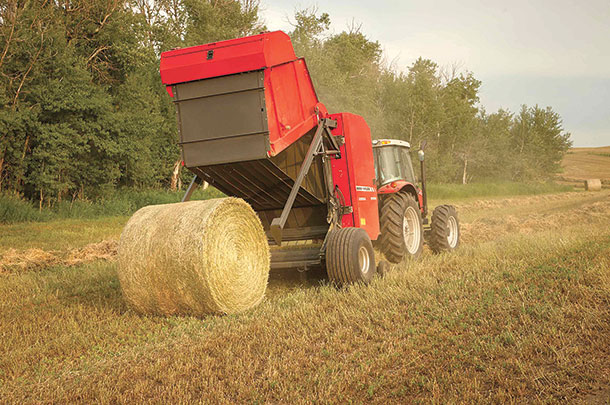
Wegert explained that real-time bale monitoring is accomplished with the C1000 console monitor. The display includes a three-bar bale shape monitor that changes color according to bale shape. The bar display indicates if an hourglass or barrel-shape bale is being made as well as relative bale height. The console monitor can also change the auto-tie function to match crop and wrap types.
Describing the Hesston 1800 Series square balers, Wegert said, “On most balers, the plunger has to form, cut and compress the hay that’s side-delivered through the bale chamber into an individual bale slice. These operations on the 1800 Series are evenly distributed between the pre-forming chamber, packer/stuffer and plunger, which help minimize peak loading on the entire drive system. From the time hay enters the pickup until the finished bale drops out the back, the crop follows a straight path.
There are no right-angle turns and no high pickup lifts to shake or tear valuable leaves from the stems. Instead, the crop is lifted just high enough to feed straight into a pre-packer chamber that actually pre-forms each flake before sweeping it into the bale chamber. The results are higher-quality bales that are easier to stack and easier to feed.
“An optional hydraulic density control senses resistance of bales sliding through the bale chamber and sets bale tension accordingly,” Wegert said. “The system adjusts automatically to keep bale density constant even when moisture conditions change. This eliminates need for the operator to get on and off the tractor to fine-tune the settings.
“Another benefit of straight-path design is that field and road positions are the same, which means the baler doesn’t have to be re-positioned to move to and from the field. It also means the baler and any wagon towed behind it is in a straight line. This provides less twist or strain on the baler frame.”
2. Hesston 1800 Series square baler
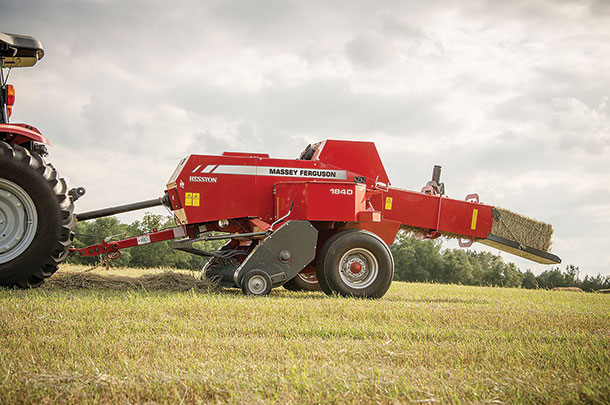 Popularity of disc mowers continues to grow, and manufacturers continue to make improvements. Earlier models had a number of hubs across the cutting width, with each hub having a small (18-inch) rotating disc with knives. All the mower hubs were in one large gearbox, so if one blade hit something and a gear-tooth broke, the whole gearbox was damaged. Another way to explain this action is, “If anything broke, everything broke.”
Popularity of disc mowers continues to grow, and manufacturers continue to make improvements. Earlier models had a number of hubs across the cutting width, with each hub having a small (18-inch) rotating disc with knives. All the mower hubs were in one large gearbox, so if one blade hit something and a gear-tooth broke, the whole gearbox was damaged. Another way to explain this action is, “If anything broke, everything broke.”
“Massey Ferguson fixed this problem by equipping the cutter bar with a roll/shear pin for every disc,” Wegert said. “When the disc hits a hard object, the shear pin breaks outside of the cutter bed, preventing any internal damage and eliminating contamination of the oil bath with pieces of metal.”
Vermeer
Al Rogers of J5 Tractors at Normangee, Texas, began his discussion by relating the history of Vermeer and then talked about the features of the company’s disc mowers.
“Vermeer disc mowers have an exclusive bi-shaft design that provides each disc with its own set of gears, bearings and lubricants,” said Rogers. “The gears stay in the grease, even when mowing at angles. Extra-wide skid shoes eliminate pinch points to protect against rock damage and simplify blade replacement.”
Moving to hay rakes, Rogers said, “Windrow widths can now be changed hydraulically from the tractor cab to maximize raking efficiency and custom-shape the windrows to match the baler pickup. Optional basket speed control is available on the R2300 model, which also allows adjustment for different crops and conditions.
Operators can engage and disengage the transport lock on the hay rakes without leaving the tractor. The field transport locks will automatically lock when folding in and can be disengaged by pulling a rope from the tractor seat.”
3. Vermeer disc mower
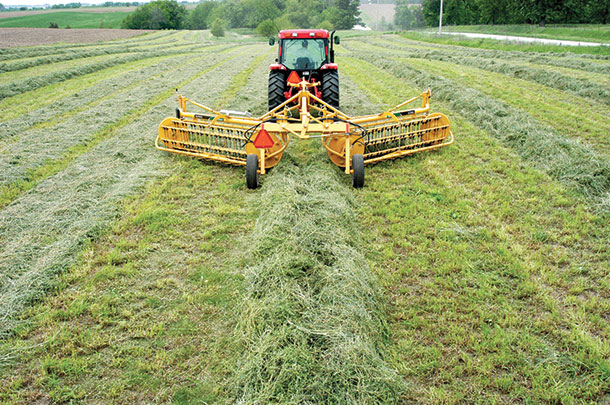
“Direct-crop feed on the round balers enables the forage crop to be fed directly to the bottom drum and bale-starting chamber without wrestling through a series of secondary stop-and-start stuffer drives or rotors,” Rogers said as he walked to a different piece of equipment. “Fewer rotors and accompanying parts mean less maintenance time and cost.
The patented dual-stage belt system tightens the belts at the beginning of a bale, reducing the chamber size by 50 percent and allowing the hay to turn quicker. The optional pickup clutch automatically stops the pickup when the desired bale size is reached, reducing pickup wear and ensuring bale consistency.
An optional auto-lube greasing system, controlled through the E-Link Pro display, provides automatic lubrication to critical bearings at user-defined intervals.”
Case IH
John Mayer with Associated Supply Company at Brenham, Texas, represented Case IH equipment at the forage field day.
“Case IH round balers are designed and are built to deliver high-capacity hay production,” Mayer said.
4. Case IH RB565 round baler
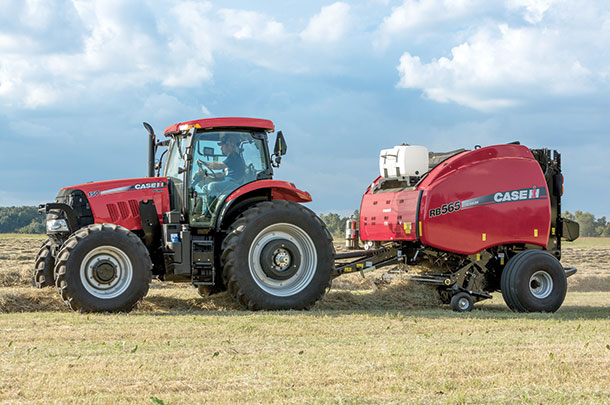
“One of the defining features of the new RB565 round baler is an overshot feeding system that moves hay into the bale chamber at a fast rate. A series of 20 tines on the feeder move crop from the outside of the pickup to the center, which results in a more consistent crop mat.
The new five-bar pickup, combined with a roller wind guard, provides a clean sweep of crop and uninterrupted feeding of material into the baler. Increased pickup width allows the baler to handle bigger windrows for maximum productivity.
“Another innovation that improves pickup, particularly in dry, light crops, is the pickup-mounted gathering wheels,” Mayer said. “The tines of these wheels gather the edges of the windrows and ensures that the maximum amount of crop is picked up.
For pickup flotation, new quick-adjust gauge wheels better follow contours and lessen the need for the operator to raise the pickup on sharp turns.”
In discussing Case IH disc mower conditioners, Mayer said, “The DC133 model has close to a 1-to-1 ratio cut width to conditioning width. Wider conditioner designs result in a thinner crop mat passing through the system for consistent and thorough crop conditioning for faster drydown. Reduced crop travel between cutter bar and conditioners minimizes plugging, especially
in cane-type crops.”
5. Case IH DC133 disc mower
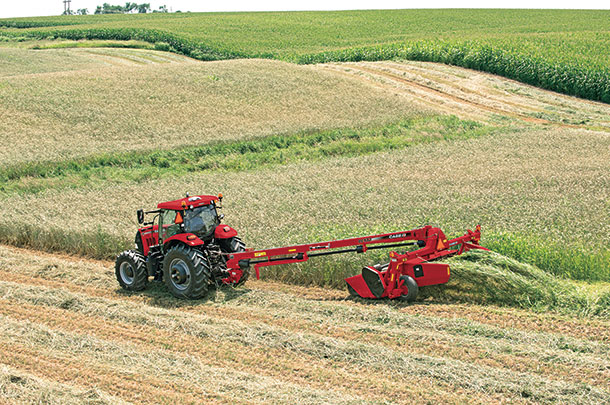
Another feature of Case IH disc mower conditioners is a swivel gearbox that does not require a steering link. The PTO shaft maintains perfect alignment between the tractor and equipment.
John Deere
Mike Hrynyk with Coufal-Prater Equipment at Bryan, Texas, represented John Deere. His presentation was centered around standard maintenance and trouble-shooting of a 469 round baler.
Hrynyk started at the front of the baler and said, “The hitch can be adjusted to match a wide array of tractor drawbar heights and tire sizes. Use of the adjustable hitch can eliminate a narrow feed opening, which often causes plugging. The adjustable hitch also allows the pickup head to follow terrain without missing hay.
Readily accessible zerk fittings are located on the PTO shaft to allow easy lubrication. An option on all 9 Series round balers is the drawbar flap that helps keep hay from getting caught on the hitch. The flap can be attached or removed without having to unhook the baler from the tractor.”
Exclusive DiamondTough belts with plate-type splices are another feature of the 469 baler. John Deere’s 7-inch-wide diamond-tread design ensures fast bale starts and grips the bale to prevent slippage and reduce chaffing. Treads are self-cleaning to reduce carryover. The belts are staggered to reduce loss of fine material and are closely spaced to contain hay for fast, easy starts.
The belts reduce loss of fine material and retain hay quality and enclose 91 percent of bale width. The staggered belt roll design enables any loose hay under or behind the belts to be returned to the pickup and into the baler. This design helps prevent accumulation at the front of the baler, which could cause hay loss and belt or splice damage.
6. John Deere 469 round baler
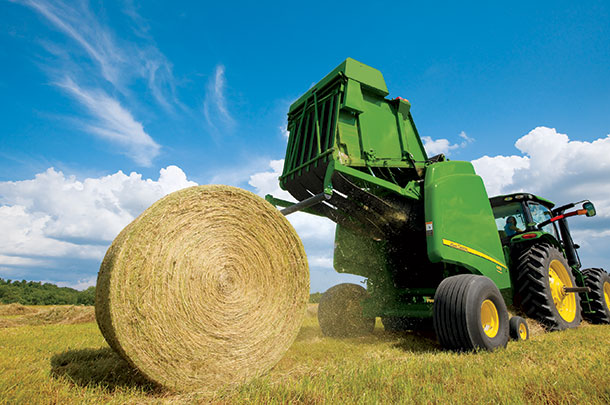
The vertical forming chamber on the 469 baler maintains uniform bale density. As hay enters the forming chamber from the pickup, belts turn it immediately to form a tight, dense core. Incoming hay then feeds between the bale and the lower-gate roll and is tightly compressed into smooth, dense layers as it enters the bale. The 469 baler is chain-driven for positive feeding.
All equipment manufacturers represented at the O.D. Butler Forage Field Day have done a tremendous job in designing hay-harvesting machinery with improved operator safety, less maintenance requirements, increased production speed and preservation of hay quality.
All equipment on display had similar features, yet each manufacturer has patented proprietary parts and systems that execute functions in a slightly different way than their competitors. To make the selection process even more complicated, each manufacturer has various models and options. In purchasing hay equipment, it is important to thoroughly explore all the options and work with the dealers to select the right machine for the job. FG
Robert Fears is a freelance writer based in Texas.











